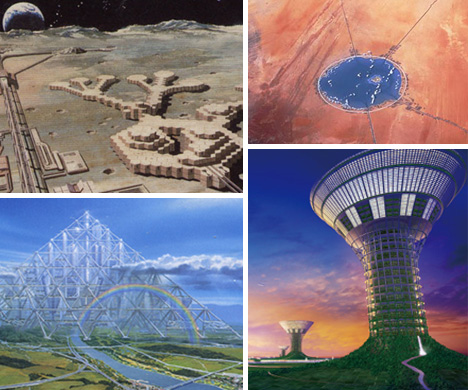
Space Hotel
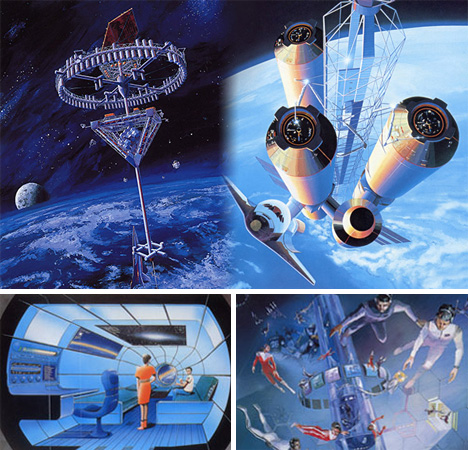
Space tourism will be big business in the future, so it only makes sense to start planning the grand space hotels of tomorrow. This low Earth orbit hotel will be connected to its docking station by a 240-meter (790-foot) elevator shaft. The hotel consists of four elements: solar energy supply (and battery for storing power), loading and unloading platform, a public area, and a sleeping quarters section with 64 guest rooms and 40 staff rooms. The sleeping rooms are arranged in a ring that rotates at a comfortable 3rpm, providing artificial gravity of 0.7G. Guests will be free to observe Earth and other space bodies while enjoying recreation and meals in microgravity.
Urban Geo-Grid Plan
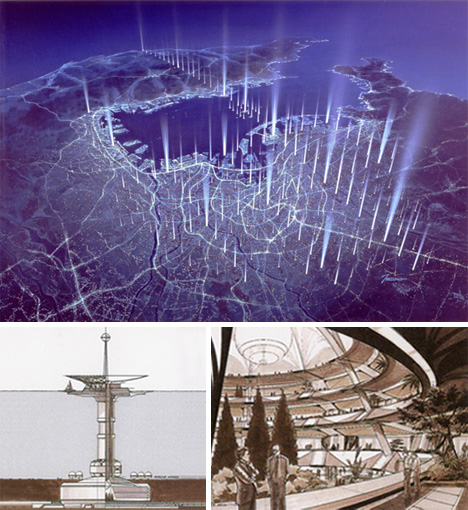
Back on Earth, urban space is running short and it’s time we figure out how to maximize our city areas. The Urban Geo-Grid Plan would move many of our essential urban functions underground to ease congestion on the surface. A vast underground network would be built that would consist of transportation, communications and energy delivery systems – all moved beneath the surface and away from the crowded city streets. There are two different sizes of underground structures: grid points and grid stations. Grid points are small and will contain community amenities like convenience stores and exhibition halls. Grid stations – including some underwater – are larger and will include office buildings, shopping centers and hotels. The ultimate vision is to create an integrated city with both above-ground and below-ground elements.
Luna Ring
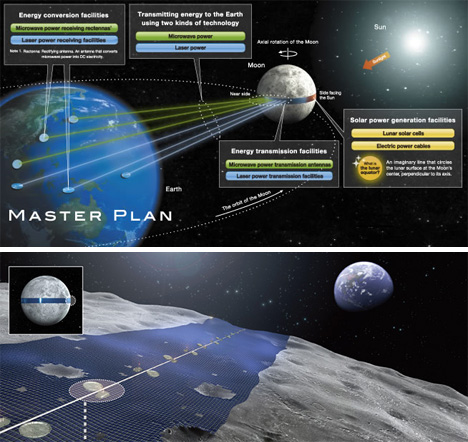
Fossil fuel stores are quickly becoming depleted and it’s obvious that future cities will need a cleaner, renewable energy source. What better source is there than unlimited solar power? The Luna Ring concept would put permanent solar collectors around the moon’s equator like a belt. The majority of the solar cells would always face the sun and collect massive amounts of solar energy, which would then be beamed to Earth via microwave power transmission antennae. The construction of the Luna Ring would be handled mostly by robots controlled remotely by people on Earth, though there would be a team of astronauts on hand to supervise the robot fleet.
Lunar Bases

Perhaps in conjunction with the lunar solar plant we will one day finally build the lunar bases that have been predicted for decades. Shimizu Corporation has developed plans for what they feel would be the most expandable and easily operable lunar bases. The base will be constructed of hexagonal modules that will allow for horizontal and vertical expansion. To greatly reduce the costs associated with transporting building materials from Earth to the moon, the modules will be constructed mainly of lunar rocks and soil. Remotely-controlled robots will do most of the work to minimize the risks that would be daunting with a human crew.
Green Float: The Environmental Island
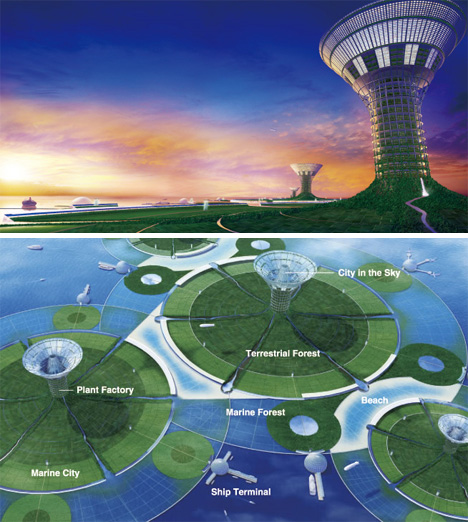
According to Shimizu Corporation, our convenient urban lives have caused us to lose touch with what’s really important and what truly makes us happy: healthy living, cultural pursuits and contact with nature. They want to re-shape the cities of the future to help us reconnect with that healthy, happy lifestyle in an organic way. Their environmental city concept will have a water-bound base with a top that extends into the sky – overall resembling a natural plant. Residential space both at the waterfront and at the top of the tower will house 40,000 people per island, while the tower will provide enough commercial space for 10,000 people to work. Island communities will be joined together in modules, making it possible for entire self-sustaining, carbon-negative cities to be built from groups of the floating platforms.
Inter Cell City
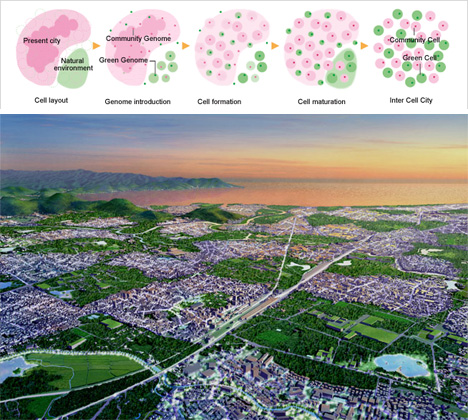
The Inter Cell City is another future city concept based on living organisms. The idea behind the concept is to create sustainable urban systems that integrate natural green spaces with occupied city spaces. Each urban community unit would operate based on citizen initiative, with every one being responsible for its own water, energy and waste management. The cities are designed to be sustainable and to cut down on fossil fuel consumption by 90% within a century.
The Pyramid City in the Air
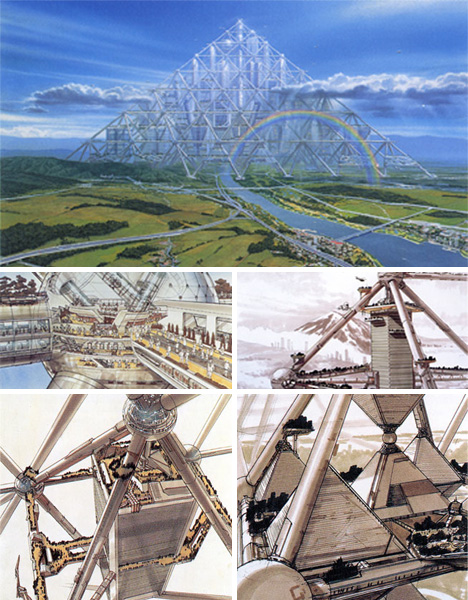
As far as self-contained cities go, this pyramid city concept is a sight to behold. It is meant to house around a million people in just a 3 square mile footprint, all of whom will be able to enjoy ample sunlight and all the rest of nature’s gifts. The truss construction consists of interconnected octahedral units, each of which can accommodate a 100-story building. The building materials are all lightweight but strong, and the shafts that connect each unit are also used to carry the plumbing, communication and electrical systems. Leisure centers, moving walkways, trains and escalators also crisscross the interior of the vast city, allowing an entire population to live, work, study and play comfortably.
Desert Aqua-Net Plan
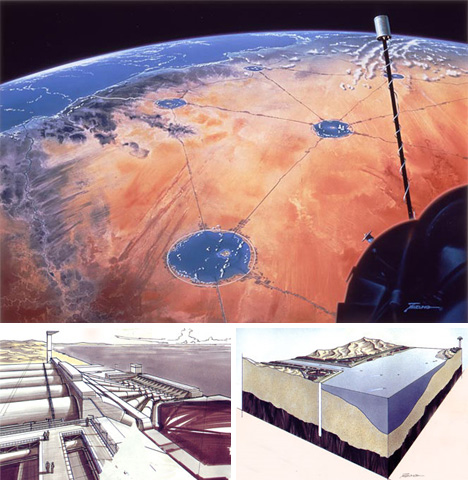
Though changing the ecological structure of a place is generally not considered very “green,” we may one day find ourselves faced with the inevitability of living in the desert. Deserts currently occupy around one-third of the planet, so Shimizu Corporation wants to utilize some of that currently uninhabitable space. Their plan is to create seawater canals that will feed artificial lakes in arid regions, then build habitable islands in those lakes. Putting the living spaces into the middle of lakes will cut down on the extreme temperatures to create pleasant living conditions. The canals could also be used for transportation, making the previously difficult-to-traverse desert much more easily navigable.
0 comments:
Post a Comment